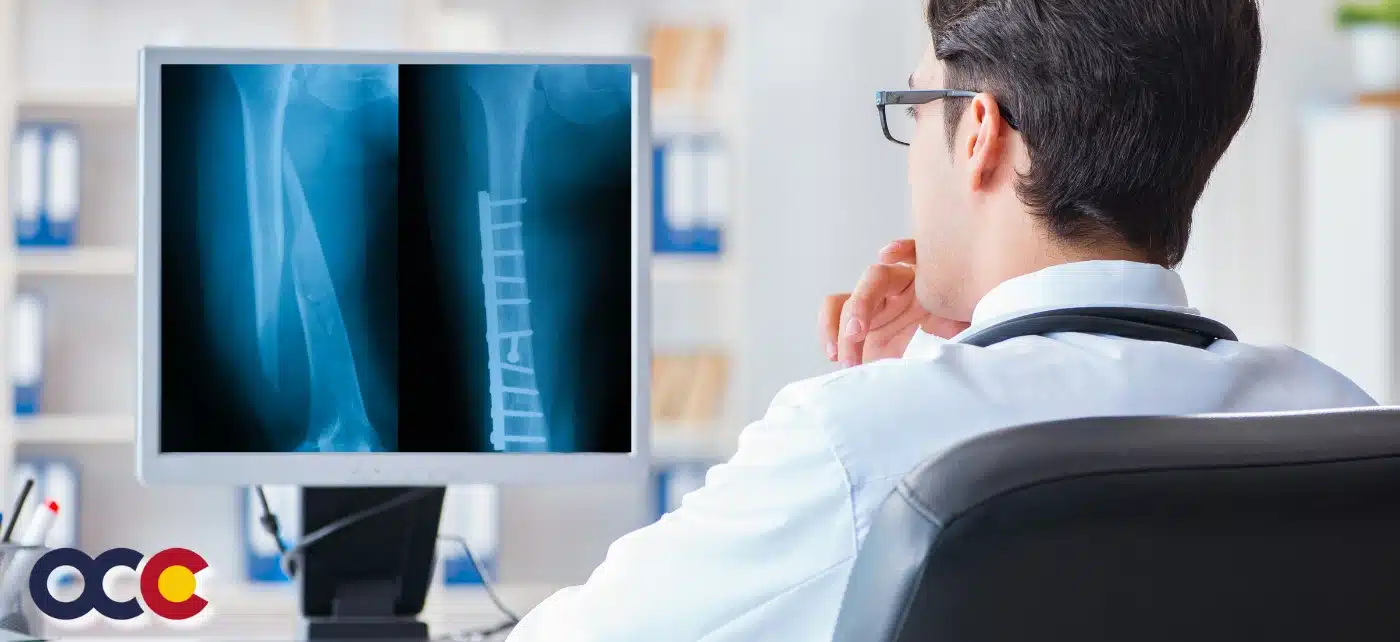A femur fracture is a serious injury that usually causes immediate, severe pain. You will not be able to put weight on the injured leg, and it may look deformed—shorter than the other leg and no longer straight. The break may also injure the muscles, tendons, ligaments, and nerves of the leg. When a femur fracture is untreated, it can mean that the bone won’t heal at all. As a result, swelling, tenderness, and pain will continue to worsen over time. That’s why you should seek help from the exceptional, experienced orthopedic specialists at OCC – Advanced Orthopedics & Sports Medicine Specialists in Denver, Parker, or Aurora, Colorado, not just for immediate treatment but to keep complications from occurring.
OVERVIEW
A broken femur, also known as a femoral fracture, is a break in the thighbone. Most adult femurs are around 18 inches long and can support as much as 30 times the weight of the body. The femur is not only the largest, strongest bone in the body, but it also has main arteries nearby that can be damaged as a result of the fracture, leading to severe bleeding or blood clots. A femur fracture can range in severity from a simple hairline crack to a complex injury that also involves damage to surrounding soft tissues. Approximately 250,000 femur fractures occur in the United States annually. The incidence peaks among the young, decreasing after age 20, and then increases again in older adults. A marked increase occurs in those over the age of 75 years. Despite the size and strength of the thigh bone, femur fractures in children are not uncommon.
ABOUT THE FEMUR
The leg has three long bones — the femur, tibia, and fibula — as well as a fourth bone, the patella, also known as the kneecap. The femur is the longest and strongest bone in the body. Located in the thigh, it extends from the hip joint to the knee joint and is crucial for supporting the body’s weight and facilitating movement. The femur consists of a shaft and two ends, called the proximal and distal ends. The proximal end articulates with the hip bone to form the hip joint, while the distal end articulates with the tibia and patella to form the knee joint. The femur plays a vital role in movement, stability, and overall structural support of the body.
WHAT IS A FEMUR FRACTURE?
A femur fracture is a break, crack, or crush injury of the thighbone. Femur fractures vary greatly, depending on what causes it to break. The pieces of bone may line up correctly (stable fracture) or be out of alignment (displaced fracture). The skin around the fracture may be intact (closed fracture) or the bone may puncture the skin (open fracture). An untreated open fracture can lead to life-threatening complications because the injury can damage the surrounding tissue and blood vessels. The tissue will become deficient in oxygen, resulting in a condition called gangrene. It may cause one to go into shock.
There are different types of femur fractures:
- A proximal femur fracture is a break in the uppermost part of the thigh bone, next to the hip joint
- A femoral shaft fracture is a break in the middle or narrow part of the thighbone
- A supracondylar femur fracture is a break just above the kneejoint
- A distal femur fracture is a break in the top part of the kneejoint
A femur fracture can cause a broken hip which is a common problem for people with osteoporosis or people who have had a knee replacement.
CAUSES
Some of the common include:
- Overuse or repetitive stress such as long-distance running
- Sports injuries from skiing, snowboarding, football, soccer and basketball
- High-speed motor vehicle collisions
- Fall from heights
- Falls from standing height or lower levels in older adults
- Falls from a piece of furniture at home
- Osteoporosis
- Low body weight/being small and thin
- Direct blows to the thigh from industrial accidents
- Certain medical conditions like bone tumors, infections, or metabolic bone disease
- In children, falling down stairs or from play items such as a jungle gym
SYMPTOMS
- Severe pain
- Inability to put weight on injured leg
- Limited range of motion
- Bruising
- Tenderness
- Swelling
- Deformity– the injured leg may be shorter than the uninjured leg, and your injured leg may turn out, away from your body
- Bone pushing out through the skin
NON-SURGICAL TREATMENTS
The patient can be placed in a cast that extends from the rib cage to the toes, or put on bed rest with weights and pulleys creating traction. Varying forms of acetaminophen such as Tylenol with codeine may help with pain.
WHEN IS SURGERY INDICATED?
It is very unusual for a femur fracture to heal without surgery. Depending on the severity of the fracture, the surgeon may recommend one of the following procedures:
Internal fixation: In severe or complicated fractures, a surgeon may insert metal rods or plates and screws into the femur to hold the fractured bone in place while it heals.
External fixation: If internal fixation is not an option, metal pins can be inserted through the skin into the fractured bone. These pins are attached to a bar that sits outside the skin on the thigh. The pins and bar hold the bone fragments in place and the bone in alignment while it heals.
Intramedullary nails or rods: This is the most common surgery. The surgeon may make small incisions in the skin and insert nails into the bone. The nails realign the bone and hold it in place while still allowing growth and natural remodeling.
GETTING THE RIGHT DIAGNOSIS. GETTING THE RIGHT DOCTOR.
The most common way to evaluate a fracture is with X-rays. X-rays can show whether a bone is intact or broken. They can also show the type of fracture and where it is located within the femur. If your doctor still needs more information after reviewing your X-rays, they may order a CT scan. A CT scan can provide your doctor with valuable information about the severity of the fracture. For example, sometimes the fracture lines can be very thin and hard to see on an X-ray. A CT scan can help your doctor see the lines more clearly. It might require an MRI or bone scan if further information is needed. The capable and accomplished surgeons at Advanced Orthopedics in Denver, Parker, or Aurora, Colorado, provide responsive, compassionate, and thorough care. Their expertise allows for precise diagnoses of femur fractures of all complexities. At Advanced Ortho, they are noted for their outstanding results. And the quicker you heal, the faster you can get back to life as normal. Schedule a consult today.












